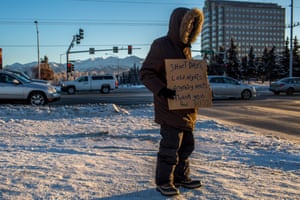Quote begins:
However, for years in their adulthood, Nickolai and Amaktoolik lived on the streets of Anchorage, Alaska’s largest city. Both lived with chronic alcoholism.

Bodies also appear in the spring, as the snow recedes, often surrounded by plastic bottles once filled with alcohol or mouthwash. The most at-risk are those who have poorly treated physical or mental illnesses and years of alcoholism. The dead are disproportionately Alaska Natives, police and homelessness advocates say, who make up 20% of the general population but constitute half of the clients in shelters.
There are about 3,000 to 4,000 people without permanent housing in Anchorage, though many of those are living in shelters or couch surfing. At the last count in August, about 450 people were living in emergency shelters and in outside camps.
Each winter, the city scrambles to find enough shelter beds to prevent deaths from exposure. Almost always, the demand is greater than the supply. At times during November, Brother Francis, the city’s largest shelter, turned away 50 people a night, said Lisa Caldeira, its program director.
The city was able to open more than 100 extra beds in early December, but Brother Francis is still turning people away. “It’s not enough,” Caldeira said.
Kim Kovol, deputy director of the city’s largest soup kitchen, Bean’s Cafe, said her staff walk the streets every morning this time of year in search of people who need help. “Our staff go out and wake everybody,” she said. “All you do is pray they are not dead.”
When someone begins drinking in the cold, they may have a false sense of warmth. Continued drinking slows circulation in the extremities, doctors say, which can lead to frostbite. It also causes dehydration, exacerbating the symptoms of hypothermia, including poor reasoning and drowsiness.
“People pass out,” Kovol said. “They pass out on the street, in the sidewalk, in parking lots.”
Nancy Burke, housing and homeless coordinator for Anchorage, said the drug of choice in the city is alcohol. The rate of alcohol abuse among Alaska Natives is consistently the highest among all ethnic groups, mirroring that of American Indians in the lower 48 states, according to federal statistics.